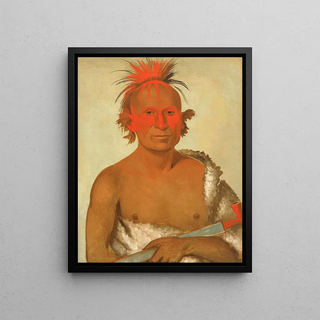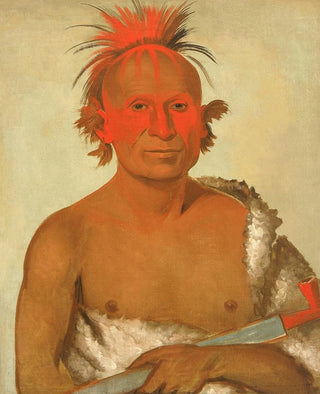Art print | Pasheepah Little Stabbing Chief, the youngest of the Black Hawks Braves - George Catlin


View from behind

Frame (optional)
In the rich and complex universe of 19th-century American art, the artwork "Pasheepah Little Stabbing Chief, the youngest of the Black Hawks Braves" by George Catlin stands out for its narrative depth and authentic portrayal of Indigenous peoples. This painting, part of a series dedicated to documenting Native American cultures, offers a fascinating glimpse into the life and traditions of the Sioux. Catlin, as a passionate observer, captured not only the physical appearance of his subjects but also the essence of their cultural identity, making his work timeless and highly relevant historically.
Style and uniqueness of the artwork
Catlin's style is characterized by a realistic and detailed approach, blending a palette of vibrant colors with carefully thought-out compositions. In "Pasheepah Little Stabbing Chief," the young chief is depicted with an intensity that immediately draws the viewer's attention. The artist employs painting techniques that highlight the distinctive features of his model, such as traditional ornaments and typical clothing, while infusing life and personality into his subject. The piece also stands out for its atmosphere, where the gaze of the young chief seems to pierce through the viewer, creating a powerful emotional connection. Catlin's ability to establish a link between the subject and the observer makes this painting a key piece of narrative art.
The artist and his influence
George Catlin, often regarded as the first painter to dedicate his career to the representation of Native American cultures, played a crucial role in preserving the history and traditions of Indigenous peoples. Traveling across the United States, he documented scenes of daily life, ceremonies, and portraits of chiefs, thereby contributing to a better understanding of these often little-known cultures. His artistic approach, combining sensitivity and precision, influenced many artists and art historians, who saw in him a pioneer of ethnographic representation. By exhibiting his works in museums and galleries, Catlin also raised public awareness of the richness of Native American cultures, leaving a lasting legacy that continues

Matte finish

View from behind

Frame (optional)
In the rich and complex universe of 19th-century American art, the artwork "Pasheepah Little Stabbing Chief, the youngest of the Black Hawks Braves" by George Catlin stands out for its narrative depth and authentic portrayal of Indigenous peoples. This painting, part of a series dedicated to documenting Native American cultures, offers a fascinating glimpse into the life and traditions of the Sioux. Catlin, as a passionate observer, captured not only the physical appearance of his subjects but also the essence of their cultural identity, making his work timeless and highly relevant historically.
Style and uniqueness of the artwork
Catlin's style is characterized by a realistic and detailed approach, blending a palette of vibrant colors with carefully thought-out compositions. In "Pasheepah Little Stabbing Chief," the young chief is depicted with an intensity that immediately draws the viewer's attention. The artist employs painting techniques that highlight the distinctive features of his model, such as traditional ornaments and typical clothing, while infusing life and personality into his subject. The piece also stands out for its atmosphere, where the gaze of the young chief seems to pierce through the viewer, creating a powerful emotional connection. Catlin's ability to establish a link between the subject and the observer makes this painting a key piece of narrative art.
The artist and his influence
George Catlin, often regarded as the first painter to dedicate his career to the representation of Native American cultures, played a crucial role in preserving the history and traditions of Indigenous peoples. Traveling across the United States, he documented scenes of daily life, ceremonies, and portraits of chiefs, thereby contributing to a better understanding of these often little-known cultures. His artistic approach, combining sensitivity and precision, influenced many artists and art historians, who saw in him a pioneer of ethnographic representation. By exhibiting his works in museums and galleries, Catlin also raised public awareness of the richness of Native American cultures, leaving a lasting legacy that continues






